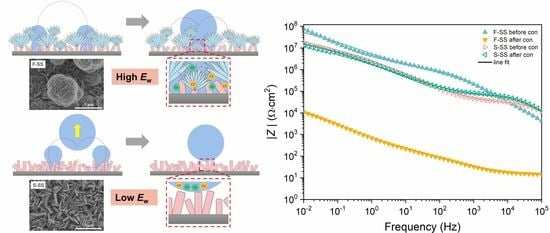Effect of Microstructure on Coalescence-Induced Droplet Jumping Behavior of a Superhydrophobic Surface and Its Application for Marine Atmospheric Corrosion Protection
Abstract
:1. Introduction
2. Experimental Section
2.1. Materials
2.2. Preparation of Superhydrophobic Surfaces
2.3. Characterization
2.4. Simulated Condensation Experiments
2.5. Electrochemical Measurements
3. Result and Discussion
3.1. Morphology, Composition, and Wettability
3.2. Coalescence-Induced Droplet Jumping Behavior
3.3. Marine Atmospheric Corrosion Protection Performance
3.4. Atmospheric Corrosion Resistance Mechanisms
4. Conclusions
- (1)
- The contact angles of the two superhydrophobic surfaces were 156° and 160°, respectively;
- (2)
- It was found that the S-SS could realize the CIDJB, the wetting coverage was maintained at about 10–20%, and the condensation suppression efficiency was greater than 80% in the simulated condensation experiments;
- (3)
- The results of the EIS measurements showed that the corrosion inhibition efficiency (η) of the S-SS remained at 99.98% before and after condensation, while the η of the F-SS decreased from 99.99% to 83.36%. These differences resulted from the different microstructures of the two superhydrophobic surfaces. Compared to the S-SS, the F-SS had a layer of 1–3.5 μm “flowers” composed of stacked nanosheets, and the larger solid–liquid contact area resulted in higher interfacial adhesion (Ew). The lower Ew was required to be overcome; thus, it was beneficial for the S-SS to realize the droplet jumping behavior;
- (4)
- The S-SS exhibited excellent corrosion resistance due to the wettability transition of droplet jumping behavior induced by coalescence, which facilitated the restoration of the air film.
Supplementary Materials
Author Contributions
Funding
Data Availability Statement
Conflicts of Interest
References
- Ma, Y.; Li, Y.; Wang, F. Corrosion of low carbon steel in atmospheric environments of different chloride content. Corros. Sci. 2009, 51, 997–1006. [Google Scholar] [CrossRef]
- Wang, P.; Li, C.Y.; Zhang, D. Recent advances in chemical durability and mechanical stability of superhydrophobic materials: Mul-ti-strategy design and strengthening. J. Mater. Sci. Technol. 2022, 129, 40–69. [Google Scholar] [CrossRef]
- Bai, Z.G.; Zhu, J.Y. A Facile Preparation Method for Corrosion-Resistant Copper Superhydrophobic Surfaces with Ordered Mi-crostructures by Etching. Coatings 2023, 13, 1151. [Google Scholar] [CrossRef]
- Zheng, X.H.; Yang, Y.Q.; Xian, Y.; Chen, H.; Cai, W. In Situ Grown Vertically Oriented Graphene Coating on Copper by Plas-ma-Enhanced CVD to Form Superhydrophobic Surface and Effectively Protect Corrosion. Nanomater.-Basel 2022, 12, 3202. [Google Scholar] [CrossRef]
- Cao, J.; Lv, Z.; Liao, B.; Chen, D.; Tong, W.; Zong, Z.; Li, C.; Xiang, T. In-situ fabrication of superhydrophobic surface on copper with excellent anti-icing and anti-corrosion properties. Mater. Today Commun. 2022, 33, 104633. [Google Scholar] [CrossRef]
- Boreyko, J.B.; Chen, C.-H. Self-Propelled Dropwise Condensate on Superhydrophobic Surfaces. Phys. Rev. Lett. 2009, 103, 184501. [Google Scholar] [CrossRef] [Green Version]
- Chu, F.; Lin, Y.; Yan, X.; Wu, X. Quantitative relations between droplet jumping and anti-frosting effect on superhydrophobic surfaces. Energy Build. 2020, 225, 110315. [Google Scholar] [CrossRef]
- He, J.-G.; Zhao, G.-L.; Dai, S.-J.; Li, M.; Zou, G.-S.; Wang, J.-J.; Liu, Y.; Yu, J.-Q.; Xu, L.-F.; Li, J.-Q.; et al. Fabrication of Metallic Superhydrophobic Surfaces with Tunable Condensate Self-Removal Capability and Excellent Anti-Frosting Performance. Nanomaterials 2022, 12, 3655. [Google Scholar] [CrossRef]
- Watson, G.S.; Gellender, M.; Watson, J.A. Self-propulsion of dew drops on lotus leaves: A potential mechanism for self cleaning. Biofouling 2014, 30, 427–434. [Google Scholar] [CrossRef]
- Xu, W.; Huang, L.B.; Wong, M.C.; Chen, L.; Bai, G.X.; Hao, J.H. Environmentally Friendly Hydrogel-Based Triboelectric Nanogenerators for Versatile Energy Harvesting and Self-Powered Sensors. Adv. Energy Mater. 2017, 7, 14094–14103. [Google Scholar] [CrossRef]
- Yao, Y.; Jiang, T.; Zhang, L.; Chen, X.; Gao, Z.; Wang, Z.L. Charging System Optimization of Triboelectric Nanogenerator for Water Wave Energy Harvesting and Storage. ACS Appl. Mater. Interfaces 2016, 8, 21398–21406. [Google Scholar] [CrossRef]
- Zhang, T.-Y.; Mou, L.-W.; Zhang, Y.-C.; Zhang, J.-Y.; Li, J.-Q.; Fan, L.-W. Hierarchical microcavity topography for enhancement of water vapor condensation heat transfer by regulating droplet dynamics and droplet size distribution. Case Stud. Therm. Eng. 2021, 24, 100882. [Google Scholar] [CrossRef]
- Zhao, C.; Yan, X.; He, W.; Huang, Z.; Bo, H.; Chen, F.; Miljkovic, N. Exploring the limits of condensation heat transfer: A numerical study of microscale-confined condensation between parallel surfaces having wetting contrast. Int. J. Heat Mass Transf. 2022, 193, 122758. [Google Scholar] [CrossRef]
- Li, T.; Li, J.; Wang, L.; Duan, Y.; Li, H. Coalescence of Immiscible Liquid Metal Drop on Graphene. Sci. Rep. 2016, 6, 34074. [Google Scholar] [CrossRef] [PubMed] [Green Version]
- Wang, K.; Liang, Q.; Jiang, R.; Zheng, Y.; Lan, Z.; Ma, X. Numerical Simulation of Coalescence-Induced Jumping of Multidroplets on Superhydrophobic Surfaces: Initial Droplet Arrangement Effect. Langmuir 2017, 33, 6258–6268. [Google Scholar] [CrossRef] [PubMed]
- Li, S.; Chu, F.; Zhang, J.; Brutin, D.; Wen, D. Droplet jumping induced by coalescence of a moving droplet and a static one: Effect of initial velocity. Chem. Eng. Sci. 2020, 211, 115252. [Google Scholar] [CrossRef]
- Gao, S.; Qu, J.; Liu, Z.; Ma, W. Sequential self-propelled morphology transitions of nanoscale condensates enable a cascade jumping-droplet condensation. Nano Energy 2023, 113, 108558. [Google Scholar] [CrossRef]
- Tang, S.; Li, Q.; Yu, Y. Enhanced coalescence-induced droplet jumping on V-shaped superhydrophobic surface with a triangular prism. Phys. Fluids 2023, 35, 023306. [Google Scholar] [CrossRef]
- Huang, B.; Zhang, X.; Li, X.; Zhang, H.; He, F.; Hao, P.; Yao, Z. Numerical investigation of droplet condensation and self-propelled jumping on superhydrophobic microcolumned surfaces. Phys. Fluids 2023, 35, 052103. [Google Scholar]
- Liu, X.; Wang, P.; Zhang, D.; Chen, X. Atmospheric Corrosion Protection Performance and Mechanism of Superhydrophobic Surface Based on Coalescence-Induced Droplet Self-Jumping Behavior. ACS Appl. Mater. Interfaces 2021, 13, 25438–25450. [Google Scholar] [CrossRef]
- Lu, D.Q.; Zhao, M.R.; Zhang, H.L.; Yong, Y.; Zheng, Y.L. Self-Enhancement of Coalescence-Induced Droplet Jumping on Superhy-drophobic Surfaces with an Asymmetric V-Groove. Langmuir 2020, 36, 5444–5453. [Google Scholar] [CrossRef] [PubMed]
- Miljkovic, N.; Preston, D.J.; Enright, R.; Wang, E.N. Electric-Field-Enhanced Condensation on Superhydrophobic Nanostructured Surfaces. ACS Nano 2013, 7, 11043–11054. [Google Scholar] [CrossRef] [PubMed]
- Vahabi, H.; Wang, W.; Mabry, J.M.; Kota, A.K. Coalescence-induced jumping of droplets on superomniphobic surfaces with ma-crotexture. Sci. Adv. 2018, 4, 11. [Google Scholar] [CrossRef] [PubMed] [Green Version]
- Burriel-Marťi, F.; Lucena-Conde, F.; Bolle-Taccheo, S. Enhancement of the reducing properties of metallic mercury in presence of complex forming ions. Anal. Chim. Acta 1953, 9, 293–304. [Google Scholar] [CrossRef]
- Brisard, G.M.; Rudnicki, J.D.; Mclarnon, F.; Cairns, E.J. Application of probe beam deflection to study the electrooxidation of copper in alkaline media. Electrochimica Acta 1995, 40, 859–865. [Google Scholar] [CrossRef]
- Enright, R.; Miljkovic, N.; Dou, N.; Nam, Y.; Wang, E.N. Condensation on Superhydrophobic Copper Oxide Nanostructures. J. Heat Transf. 2013, 135, 091304. [Google Scholar] [CrossRef]
- Chen, X.; Wang, P.; Zhang, D.; Ou, J. Rational fabrication of superhydrophobic surfaces with coalescence-induced droplet jumping behavior for atmospheric corrosion protection. Chem. Eng. J. 2022, 428, 132029. [Google Scholar] [CrossRef]
- Saleema, N.; Sarkar, D.K.; Gallant, D.; Paynter, R.W.; Chen, X.-G. Chemical Nature of Superhydrophobic Aluminum Alloy Surfaces Produced via a One-Step Process Using Fluoroalkyl-Silane in a Base Medium. ACS Appl. Mater. Interfaces 2011, 3, 4775–4781. [Google Scholar] [CrossRef] [Green Version]
- Saleema, N.; Sarkar, D.K.; Paynter, R.W.; Chen, X.-G. Superhydrophobic Aluminum Alloy Surfaces by a Novel One-Step Process. ACS Appl. Mater. Interfaces 2010, 2, 2500–2502. [Google Scholar] [CrossRef] [Green Version]
- Song, J.; Xu, W.; Lu, Y. One-step electrochemical machining of superhydrophobic surfaces on aluminum substrates. J. Mater. Sci. 2012, 47, 162–168. [Google Scholar] [CrossRef]
- Zheng, N.; Liu, J.; Wang, G.; Yao, P.; Dang, L.; Liu, Z.; Lu, J.; Li, W. Robust UV/moisture dual curable PDMS-microcapsule-silica functional material for self-healing, antifouling, and antibacterial applications. Nano Res. 2023, 16, 7810–7819. [Google Scholar] [CrossRef]
- Li, C.; Wang, P.; Zhang, D.; Wang, S. Near-Infrared Responsive Smart Superhydrophobic Coating with Self-Healing and Robustness Enhanced by Disulfide-Bonded Polyurethane. ACS Appl. Mater. Interfaces 2022, 14, 45988–46000. [Google Scholar] [CrossRef] [PubMed]
- Liu, X.; Wang, P.; Zhang, D. Facile fabrication of high-aspect-ratio super-hydrophobic surface with self-propelled droplet jumping behavior for atmospheric corrosion protection. Appl. Surf. Sci. 2021, 555, 149549. [Google Scholar] [CrossRef]
- Fowkes, F.M. Attractive forces at interfaces. Ind. Eng. Chem. 1964, 56, 40–52. [Google Scholar] [CrossRef]
- Stammitti-Scarpone, A.; Acosta, E. Solid-liquid-liquid wettability and its prediction with surface free energy models. Adv. Colloid Interface Sci. 2019, 264, 28–46. [Google Scholar] [CrossRef] [PubMed]
- Kwok, D.Y.; Neumann, A.W. Contact angle interpretation: Re-evaluation of existing contact angle data. Colloids Surfaces A 2000, 161, 49–62. [Google Scholar] [CrossRef]
- Nishino, T.; Meguro, M.; Nakamae, K.; Matsushita, M.; Ueda, Y. The lowest surface free energy based on -CF3 alignment. Langmuir 1999, 15, 4321–4323. [Google Scholar] [CrossRef]
- Cassie, A.B.D.; Baxter, S. Wettability of porous surfaces. Trans. Faraday Soc. 1944, 40, 546–551. [Google Scholar] [CrossRef]
- Chen, X.T.; Wang, P.; Zhang, D.; Wu, J.J.; Ou, J.F. How surface orientation affects coalescence-induced droplet jumping behavior and subsequent atmospheric corrosion resistance of a superhydrophobic surface? Corros. Sci. 2022, 197, 110082. [Google Scholar] [CrossRef]
- Lv, C.; Hao, P.; Yao, Z.; Song, Y.; Zhang, X.; He, F. Condensation and jumping relay of droplets on lotus leaf. Appl. Phys. Lett. 2013, 103, 021601. [Google Scholar] [CrossRef] [Green Version]
- Miljkovic, N.; Enright, R.; Nam, Y.; Lopez, K.; Dou, N.; Sack, J.; Wang, E.N. Jumping-Droplet-Enhanced Condensation on Scalable Superhy-drophobic Nanostructured Surfaces. Nano Lett. 2013, 13, 179–187. [Google Scholar] [CrossRef] [PubMed]
- Li, G.; Alhosani, M.H.; Yuan, S.; Liu, H.; Al Ghaferi, A.; Zhang, T. Microscopic Droplet Formation and Energy Transport Analysis of Condensation on Scalable Superhydrophobic Nanostructured Copper Oxide Surfaces. Langmuir 2014, 30, 14498–14511. [Google Scholar] [CrossRef] [PubMed]
- Zhang, S.; Huang, J.; Tang, Y.; Li, S.; Ge, M.; Chen, Z.; Zhang, K.; Lai, Y. Understanding the Role of Dynamic Wettability for Condensate Microdrop Self-Propelling Based on Designed Superhydrophobic TiO2 Nanostructures. Small 2017, 13, 1600687. [Google Scholar] [CrossRef] [PubMed]
- Wang, F.-C.; Yang, F.; Zhao, Y.-P. Size effect on the coalescence-induced self-propelled droplet. Appl. Phys. Lett. 2011, 98, 053112. [Google Scholar] [CrossRef]
- Enright, R.; Miljkovic, N.; Sprittles, J.; Nolan, K.; Mitchell, R.; Wang, E.N. How Coalescing Droplets Jump. ACS Nano 2014, 8, 10352–10362. [Google Scholar] [CrossRef] [PubMed]
- Tian, J.; Zhu, J.; Guo, H.-Y.; Li, J.; Feng, X.-Q.; Gao, X. Efficient Self-Propelling of Small-Scale Condensed Microdrops by Closely Packed ZnO Nanoneedles. J. Phys. Chem. Lett. 2014, 5, 2084–2088. [Google Scholar] [CrossRef]
- Marmur, A. Wetting on hydrophobic rough surfaces: To be heterogeneous or not to be? Langmuir 2003, 19, 8343–8348. [Google Scholar] [CrossRef]
- Wang, P.; Chen, X.; Li, T.; Cai, H.; Zhang, D. Exceptional atmospheric corrosion inhibition performance of super-hydrophobic films based on the self-propelled jumping behavior of water droplets. Corros. Commun. 2021, 1, 40–46. [Google Scholar] [CrossRef]
- Cui, Z.; Li, X.; Xiao, K.; Dong, C. Atmospheric corrosion of field-exposed AZ31 magnesium in a tropical marine environment. Corros. Sci. 2013, 76, 243–256. [Google Scholar] [CrossRef]
- Liu, Y.; Wang, Z.; Ke, W. Study on influence of native oxide and corrosion products on atmospheric corrosion of pure Al. Corros. Sci. 2014, 80, 169–176. [Google Scholar] [CrossRef]
- Suay, J.; Giménez, E.; Rodríguez, T.; Habbib, K.; Saura, J. Characterization of anodized and sealed aluminium by EIS. Corros. Sci. 2003, 45, 611–624. [Google Scholar] [CrossRef]
- Ding, C.; Tai, Y.; Wang, D.; Tan, L.; Fu, J. Superhydrophobic composite coating with active corrosion resistance for AZ31B magnesium alloy protection. Chem. Eng. J. 2019, 357, 518–532. [Google Scholar] [CrossRef]
- Zhang, D.; Qian, H.; Wang, L.; Li, X. Comparison of barrier properties for a superhydrophobic epoxy coating under different simulated corrosion environments. Corros. Sci. 2016, 103, 230–241. [Google Scholar] [CrossRef]
- Li, D.-W.; Wang, H.-Y.; Liu, Y.; Wei, D.-S.; Zhao, Z.-X. Large-scale fabrication of durable and robust super-hydrophobic spray coatings with excellent repairable and anti-corrosion performance. Chem. Eng. J. 2019, 367, 169–179. [Google Scholar] [CrossRef]
- Liu, T.; Chen, S.; Cheng, S.; Tian, J.; Chang, X.; Yin, Y. Corrosion behavior of super-hydrophobic surface on copper in seawater. Electrochim. Acta 2007, 52, 8003–8007. [Google Scholar] [CrossRef]
- Lee, J.; Yong, K. Surface chemistry controlled superhydrophobic stability of W18O49 nanowire arrays submerged underwater. J. Mater. Chem. 2012, 22, 20250–20256. [Google Scholar] [CrossRef]
- Ma, L.W.; Wang, J.K.; Zhao, F.T.; Wu, D.Q.; Huan, Y.; Zhang, D.W.; Zhang, Z.; Fu, W.; Li, X.; Fan, Y. Plasmon-mediated photothermal and superhydrophobic TiN-PTFE film for anti-icing/deicing applications. Compos. Sci. Technol. 2019, 181, 107696. [Google Scholar] [CrossRef]
- Wang, P.; Zhang, D.; Qiu, R.; Wu, J.J. Super-hydrophobic metal-complex film fabricated electrochemically on copper as a barrier to corrosive medium. Corros. Sci. 2014, 83, 317–326. [Google Scholar] [CrossRef]
- Wang, P.; Zhang, D.; Qiu, R. Liquid/solid contact mode of super-hydrophobic film in aqueous solution and its effect on corrosion resistance. Corros. Sci. 2012, 54, 77–84. [Google Scholar] [CrossRef]
- Liu, F.; Shan, D.Y.; Song, Y.W.; Han, E.H.; Ke, W. Corrosion behavior of the composite ceramic coating containing zirconium oxides on AM30 magnesium alloy by plasma electrolytic oxidation. Corros. Sci. 2011, 53, 3845–3852. [Google Scholar] [CrossRef]
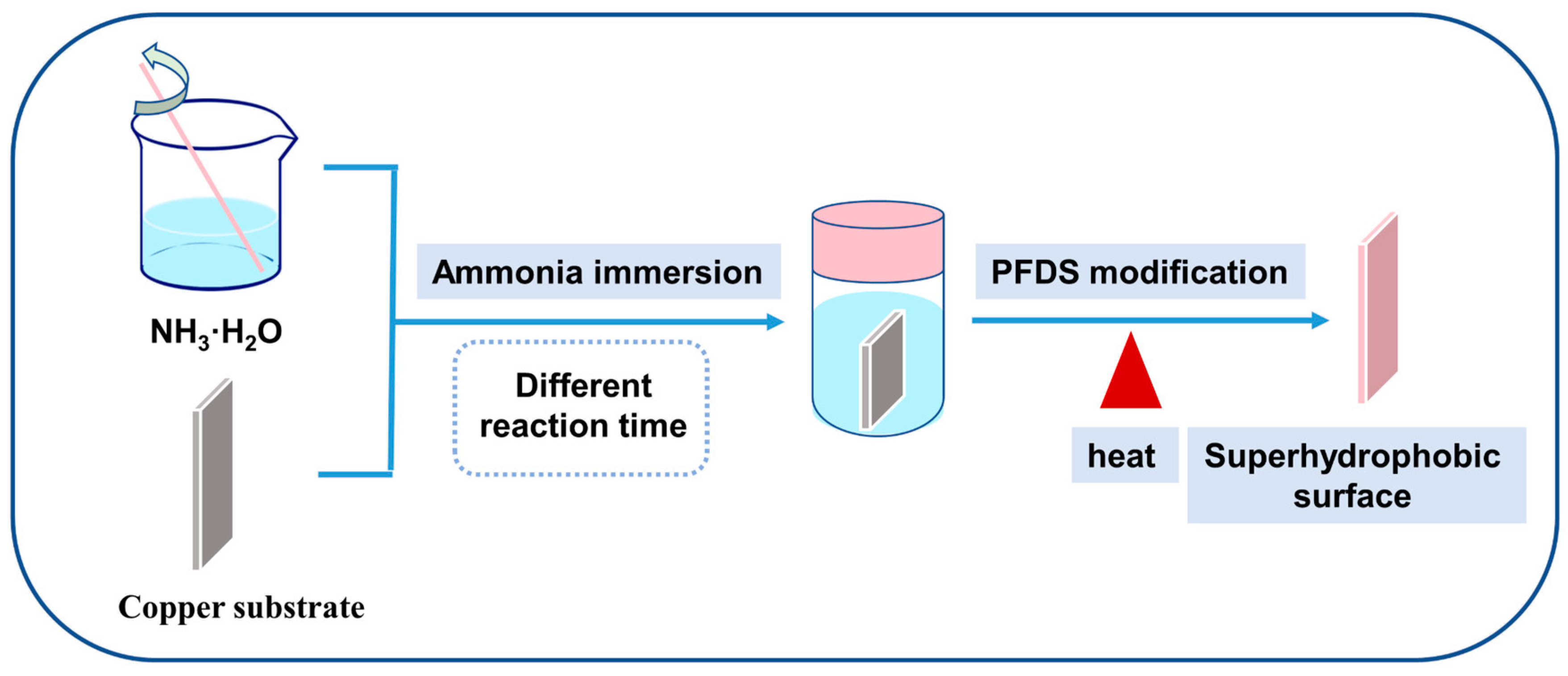
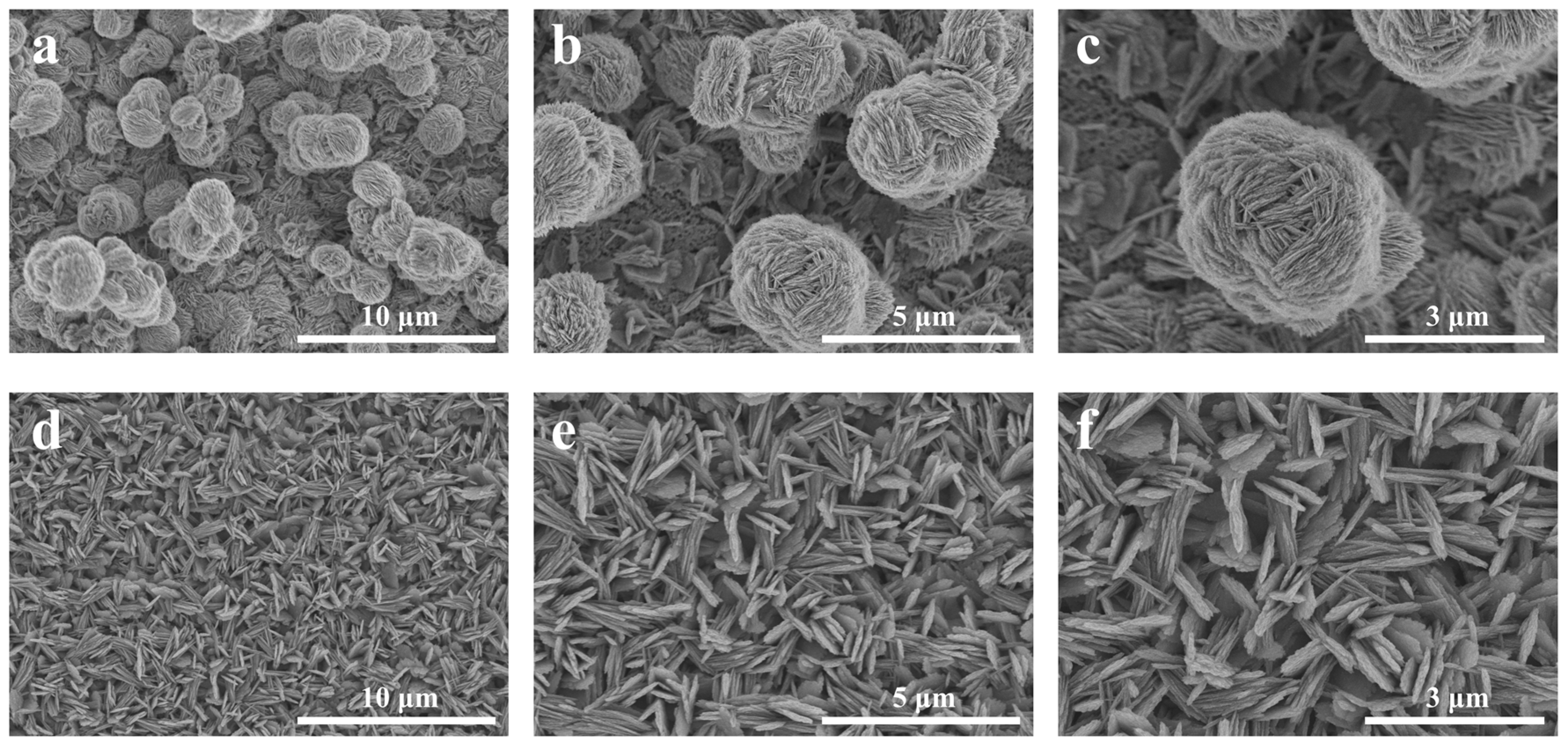
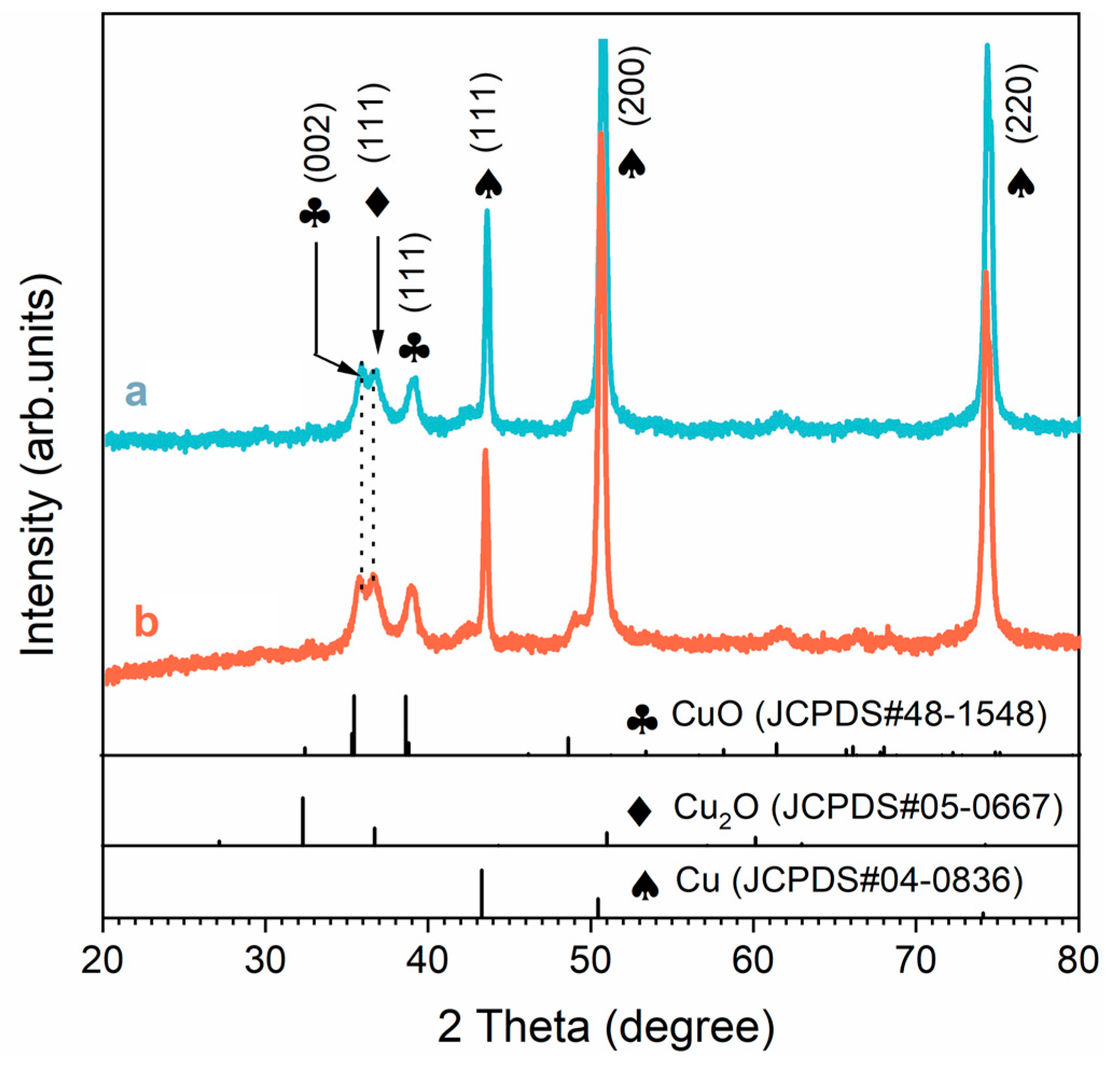

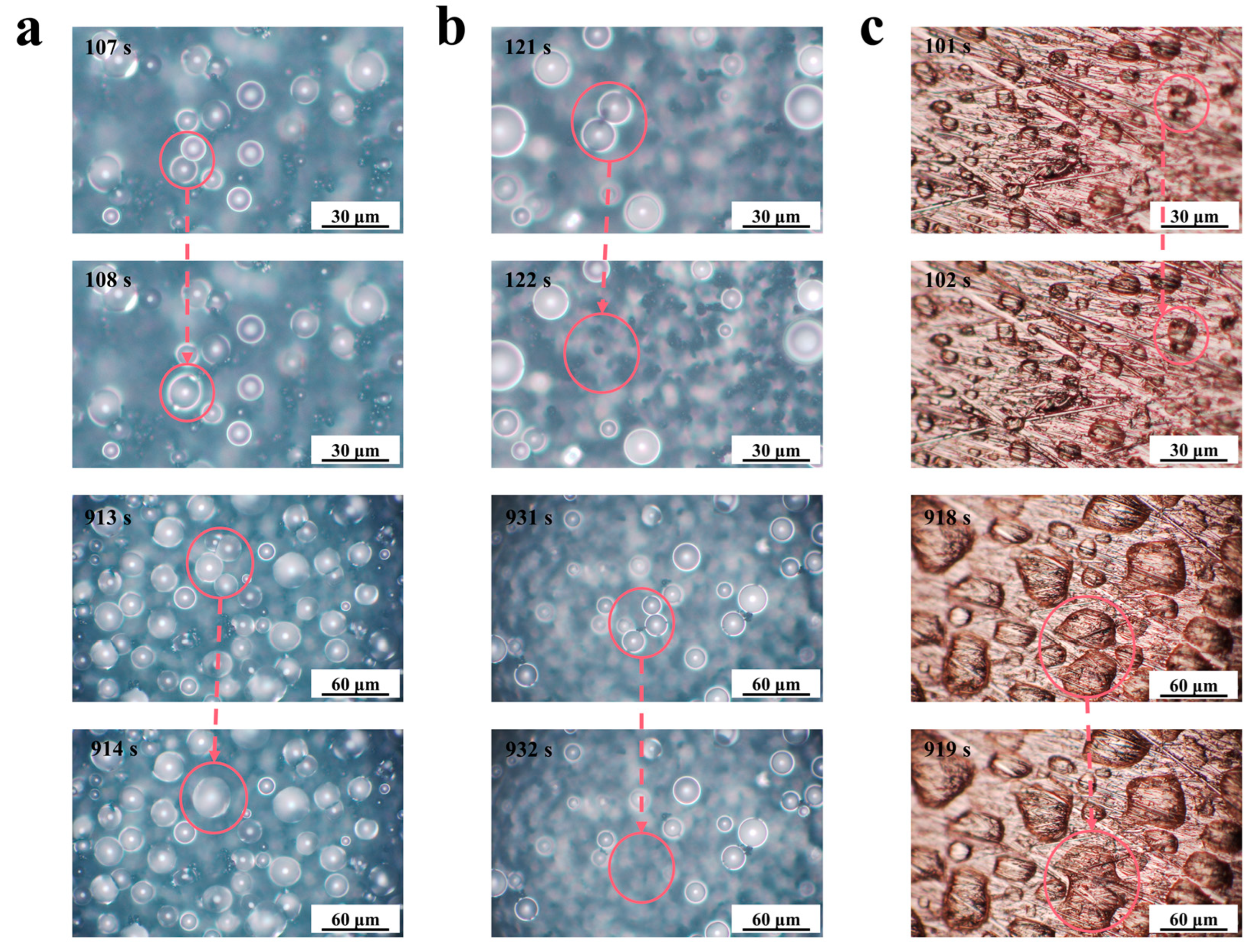
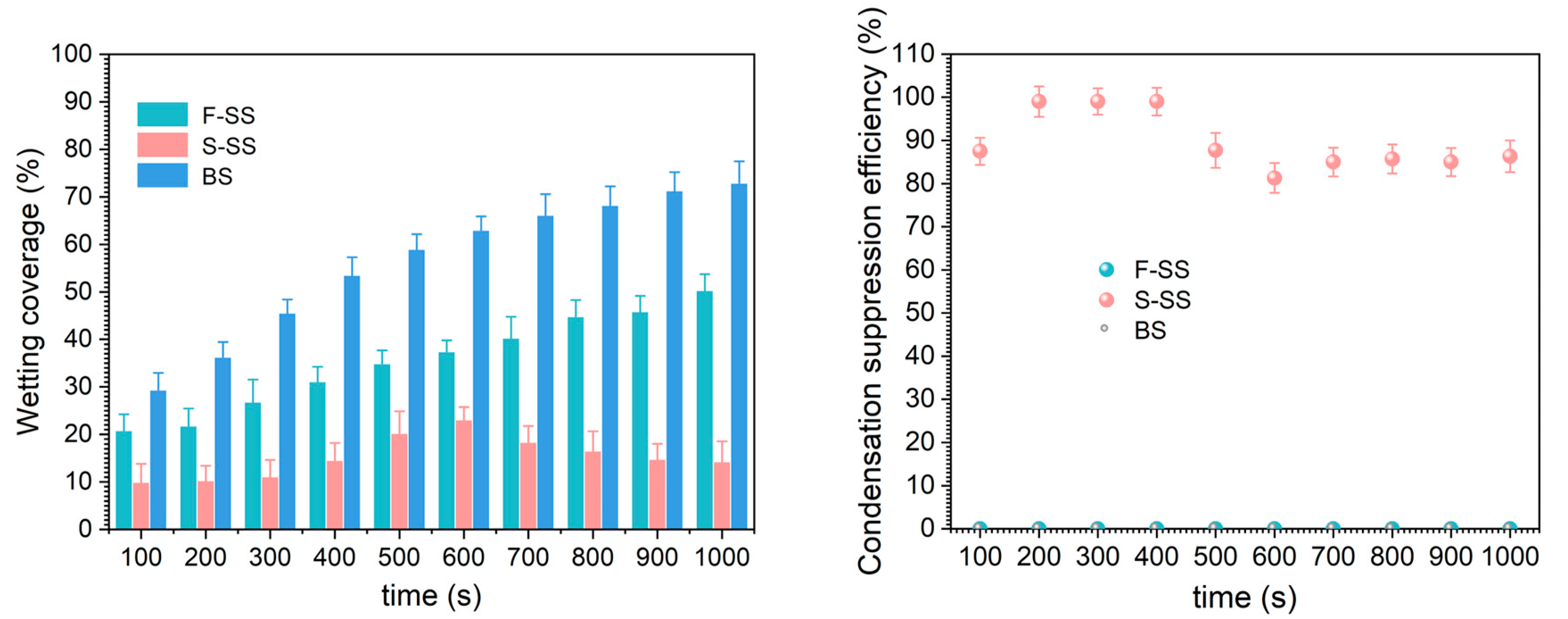
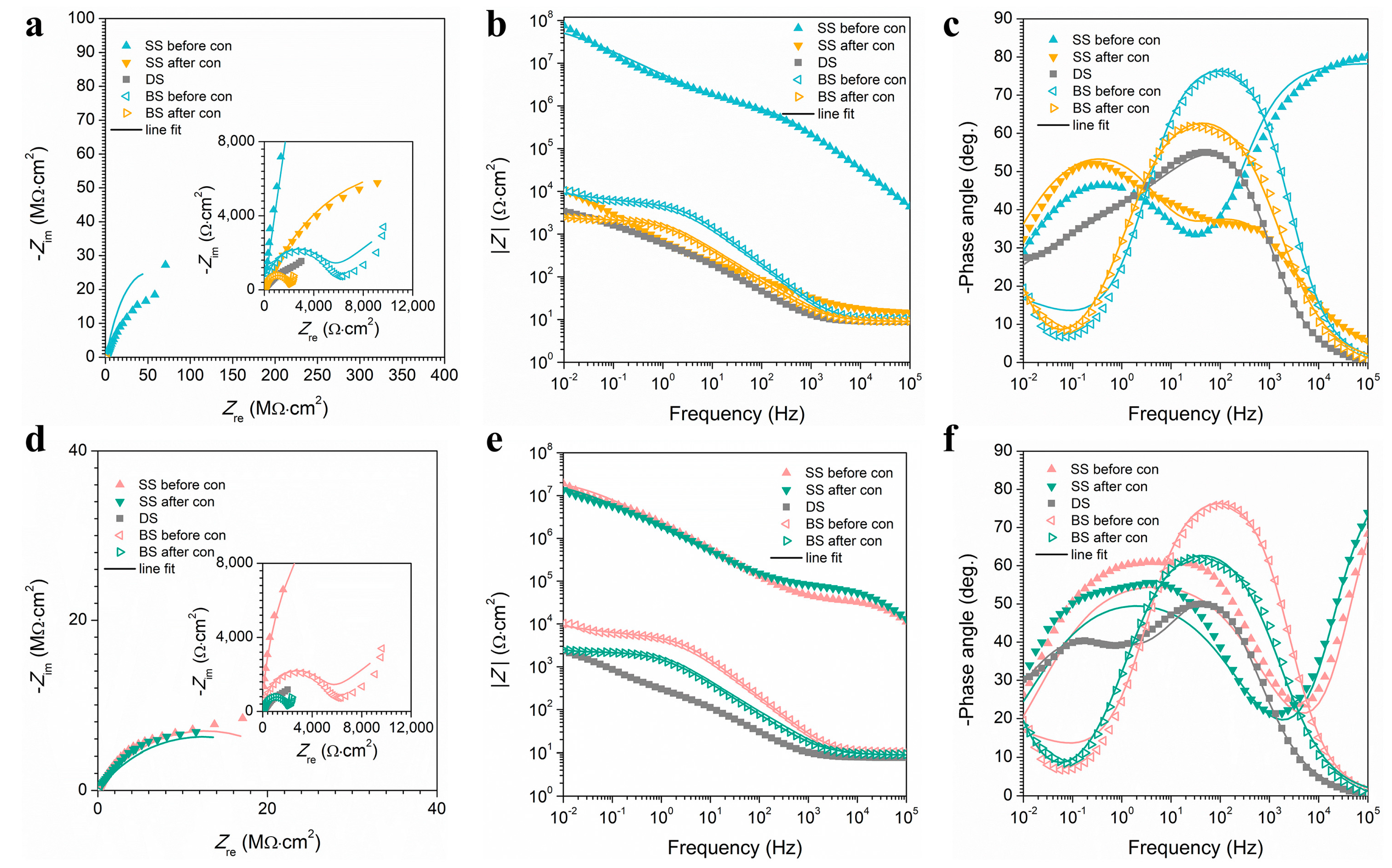
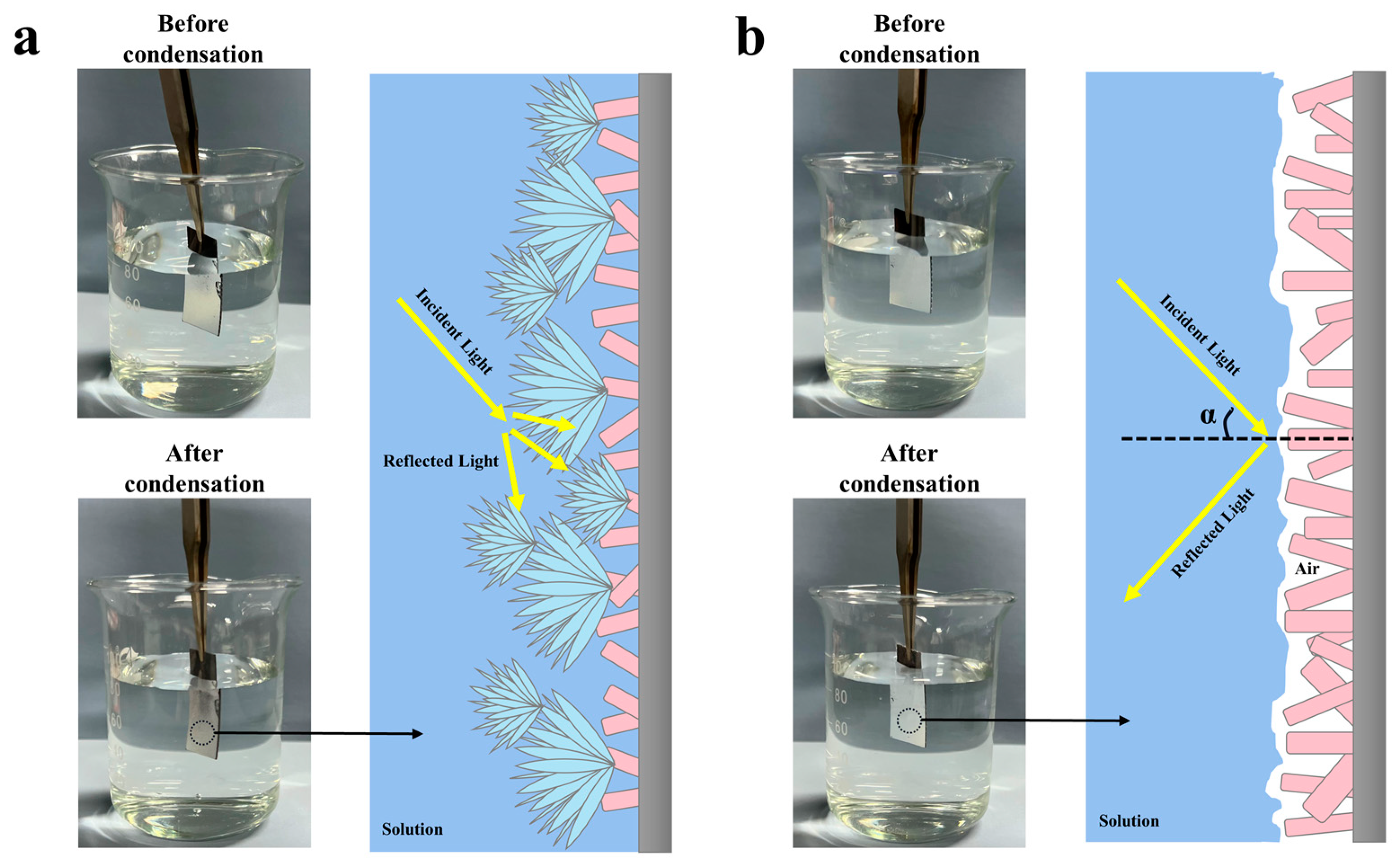

| Samples | C 1s | F 1s | Si 2p | ||||
|---|---|---|---|---|---|---|---|
| -CF3 | -CF2 | -C-CFx | -C-C | -C-F | -Si-O | ||
| F-SS | Binding Energy (eV) | 293.6 | 291.4 | 285.3 | 284.6 | 688.7 | 102.1 |
| FWHM | 1.31 | 1.29 | 1.73 | 1.70 | 1.61 | 1.77 | |
| S-SS | Binding Energy (eV) | 293.6 | 291.4 | 285.3 | 284.6 | 688.7 | 102.1 |
| FWHM | 1.31 | 1.27 | 1.75 | 1.71 | 1.55 | 1.75 | |
| Samples | Rs (Ω cm2) | Qf | Rf (Ω cm2) | Qdl | Rct (Ω cm2) | W (Ω−1 s0.5 cm−2) | Cf (µF cm−2) | Cdl (µF cm−2) | η (%) | ||
|---|---|---|---|---|---|---|---|---|---|---|---|
| Yf (F cm−2) | nf | Ydl (F cm−2) | ndl | ||||||||
| F-SS before con | 13.75 ± 0.890 | (1.98 ± 0.871) × 10−9 | 0.8740 ± 0.014 | (9.586 ± 0.178) × 105 | (6.393 ± 0.156) × 10−8 | 0.5979 ± 0.007 | (9.709 ± 0.134) × 107 | - | 1.609 × 10−4 | 5.407 × 10−6 | 99.99 |
| F-SS after con | 13.30 ± 0.781 | (2.388 ± 0.776) × 10−4 | 0.5910 ± 0.009 | 307.6 ± 12.60 | (1.978 ± 0.009) × 10−4 | 0.7321 ± 0.013 | (2.262 ± 0.113) × 104 | - | 4.459 | 22.49 | 83.36 |
| S-SS before con | 9.952 ± 0.786 | (1.664 ± 0.897) × 10−10 | 0.9812 ± 0.011 | (2.993 ± 0.134) × 105 | (1.365 ± 0.131) × 10−7 | 0.6395 ± 0.009 | (2.523 ± 0.147) × 107 | - | 1.130 × 10−4 | 6.727 × 10−5 | 99.98 |
| S-SS after con | 11.17 ± 0.889 | (2.820 ± 0.832) × 10−10 | 0.9868 ± 0.013 | (2.240 ± 0.119) × 105 | (1.808 ± 0.123) × 10−7 | 0.6284 ± 0.011 | (2.456 ± 0.151) × 107 | - | 2.170 × 10−4 | 7.756 × 10−5 | 99.98 |
| F-DS | 8.952 ± 0.789 | (6.452 ± 0.690) × 10−5 | 0.8699 ± 0.016 | 151.6 ± 9.36 | (6.275 ± 0.007) × 10−4 | 0.5643 ± 0.009 | 4757 ± 11.78 | - | 21.15 | 11.47 | - |
| S-DS | 7.699 ± 0.897 | (2.842 ± 0.756) × 10−4 | 0.7579 ± 0.015 | 200.8 ± 15.3 | (1.323 ± 0.006) × 10−3 | 0.5669 ± 0.008 | 4550 ± 16.31 | - | 40.17 | 39.73 | - |
| BS before con | 10.26 ± 0.981 | (1.432 ± 0.981) × 10−5 | 0.9089 ± 0.011 | 3615 ± 22.1 | (2.657 ± 0.011) × 10−4 | 0.6579 ± 0.011 | 5352 ± 18.11 | (2.274 ± 0.112) × 10−4 | 5.912 | 12.32 | - |
| BS after con | 8.871 ± 0.887 | (9.440 ± 0.753) × 10−5 | 0.7687 ± 0.010 | 2273 ± 21.9 | (1.775 ± 0.013) × 10−2 | 0.5824 ± 0.007 | 3764 ± 10.09 | (1.880 ± 0.009) × 10−3 | 11.20 | 4708 | - |
Disclaimer/Publisher’s Note: The statements, opinions and data contained in all publications are solely those of the individual author(s) and contributor(s) and not of MDPI and/or the editor(s). MDPI and/or the editor(s) disclaim responsibility for any injury to people or property resulting from any ideas, methods, instructions or products referred to in the content. |
© 2023 by the authors. Licensee MDPI, Basel, Switzerland. This article is an open access article distributed under the terms and conditions of the Creative Commons Attribution (CC BY) license (https://creativecommons.org/licenses/by/4.0/).
Share and Cite
Chen, Z.; Chen, X.; Sun, Y.; Wang, G.; Wang, P. Effect of Microstructure on Coalescence-Induced Droplet Jumping Behavior of a Superhydrophobic Surface and Its Application for Marine Atmospheric Corrosion Protection. Metals 2023, 13, 1413. https://doi.org/10.3390/met13081413
Chen Z, Chen X, Sun Y, Wang G, Wang P. Effect of Microstructure on Coalescence-Induced Droplet Jumping Behavior of a Superhydrophobic Surface and Its Application for Marine Atmospheric Corrosion Protection. Metals. 2023; 13(8):1413. https://doi.org/10.3390/met13081413
Chicago/Turabian StyleChen, Zhengshen, Xiaotong Chen, Yihan Sun, Guoqing Wang, and Peng Wang. 2023. "Effect of Microstructure on Coalescence-Induced Droplet Jumping Behavior of a Superhydrophobic Surface and Its Application for Marine Atmospheric Corrosion Protection" Metals 13, no. 8: 1413. https://doi.org/10.3390/met13081413
APA StyleChen, Z., Chen, X., Sun, Y., Wang, G., & Wang, P. (2023). Effect of Microstructure on Coalescence-Induced Droplet Jumping Behavior of a Superhydrophobic Surface and Its Application for Marine Atmospheric Corrosion Protection. Metals, 13(8), 1413. https://doi.org/10.3390/met13081413






